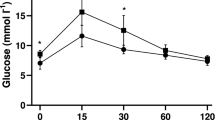Summary
Our purpose was to study the capillary density of rat gastrocnemius muscle by microangiography 7–21 days after achillotenotomy or immobilization in a plaster cast. Sixten animals were tenotomized, 12 immobilized in a plaster cast, and 4 served as controls.
The number of capillaries was counted per 1,000 muscle fibers from each sample. No site differences were found in control muscles, where on an average 1,250 capillaries per 1,000 muscle fibers were found. After tenotomy the number of capillaries was decreased 35%, 31%, and 32% on days 7, 14, and 21, respectively. In immobilized muscles the decrease in capillary density occurred slowly, the corresponding decrease being 23%, 33%, and 28% on days 7, 14, and 21, respectively.
These results indicate that the capillary density of muscular tissue is greatly decreased following the disuse produced by tenotomy or immobilization.
Similar content being viewed by others
References
Andersen P (1975) Capillary density in skeletal muscle of man. Acta Physiol Scand 95:202–205
Andersen P, Henriksson J (1977) Capillary supply of the quadriceps femoris muscle of man: Adaptative response to exercise. J Physiol 270:677–690
Andersen P, Kroese J (1978) Capillary supply in soleus and gastrocnemius muscle of man. Pfluegers Arch 75:242–249
Cotlar AM, Trosher JP, Harris SA (1963) Effect of muscle length on denervation atrophy. J Bone Joint Surg 45A:1234–1240
Hudlicka O (1973) Muscle metabolism and blood flow. In: Hudlicka O (ed). Muscle blood flow. Swets and Zeirlinger, Amsterdam
Imig GJ, Randall BF, Hines HM (1953) Effect of immobilization on muscular atrophy and blood flow. Arch Phys Med 34:296–299
Ingjer F (1978) Maximal aerobic power related to the capillary supply of the quadriceps femoris muscle in man. Acta Physiol Scand 104:238–240
Ingjer F, Brodal P (1978) Capillary supply of skeletal muscle fibers in untrained and endurance-trained women. Eur J Appl Physiol 38:291–299
Jansson E, Kijer L (1977) Muscle adaptation to extreme endurance training in man. Acta Physiol Scand 100:315–324
JÄrvinen M (1976) Healing of a crush injury in rat striated muscle. 3. A microangiographical study of the effect of early mobilisation on capillary ingrowth. Acta Path Microbiol Scand [A] 84:85–94
Józsa L, Renner A, Sántha E (1976) Ultrastrukturelle VerÄnderungen der menschlichen Skeletmuskulatur nach Sehnen- und Nervenverletzung. I. Feinstrukturelle Abweichung der Handmuskeln nach Sehnenverletzungen. Arch Orthop Unfall Chir 84:179–186
Józsa L, Renner A, Sántha E (1978a) Ultrastructural investigations of the human handmuscles after tendon and motor nerve injury. Acta Chir Acad Sci Hung 19:149–156
Józsa L, Bálint BJ, Demel S (1978b) Histochemical and ultrastructural study of human muscles after spontaneous rupture of the tendon. Acta Histochem 63:61–73
Józsa L, Bálint BJ, Demel S, Réffy A, Szilágyi I (1979) Enzyme histochemical alterations in human skeletal muscles after tenotomy and after spontaneous rupture of the tendon. Folia Histochem Cytochem 17:31–44
Lee JCY (1958) Vascular patterns in red and white muscle of rabbit. Anat Rec 132:597–611
Myrhage R, Hudlicka O (1976) The microvascular bed and capillary surface area in rat extensor hallucis proprius muscle (EHP). Microvasc Res 11:315–323
Myrhage R (1978) Capillary supply of the muscle fibre population in hindlimb muscles of the cat. Acta Physiol Scand 103:19–30
Peter JB, Darnard RJ, Edgerton VR, Gillespie CA, Stempel KB (1972) Metabolic profiles of three fibre types of skeletal muscle in guinea pigs and rabbits. Biochemistry 11:2627–2633
Plyley MJ, Groom AC (1975) Geometrical distribution of capillaries in mammalian striated muscle. Am J Physiol 228:1376–1383
Ranvier L (1874) Note sur les vassieaux sanguins et la circulation dans les muscles rouges. CR Soc Biol [Paris] 26:28–31
Romanul FCA (1965) Capillary supply and metabolism of muscle fibers. Arch Neurol 12:497–500
Stoel G (1925) über die Blutversorgung von wei\en und roten Kaninchenmuskeln. Z Zellforsch Mikrosk Anat 3:91–98
Wendelin H, Lindgren I (1970) Microangiography of the renal vessels in rabbit. Acta Radiol Scand 10:49–56
Author information
Authors and Affiliations
Additional information
Supported by a grant from the Ministry of Education and Turku University Foundation, Finland
Rights and permissions
About this article
Cite this article
Józsa, L., JÄrvinen, M., Kvist, M. et al. Capillary density of tenotomized skeletal muscles. Europ. J. Appl. Physiol. 44, 175–181 (1980). https://doi.org/10.1007/BF00421096
Accepted:
Issue Date:
DOI: https://doi.org/10.1007/BF00421096




